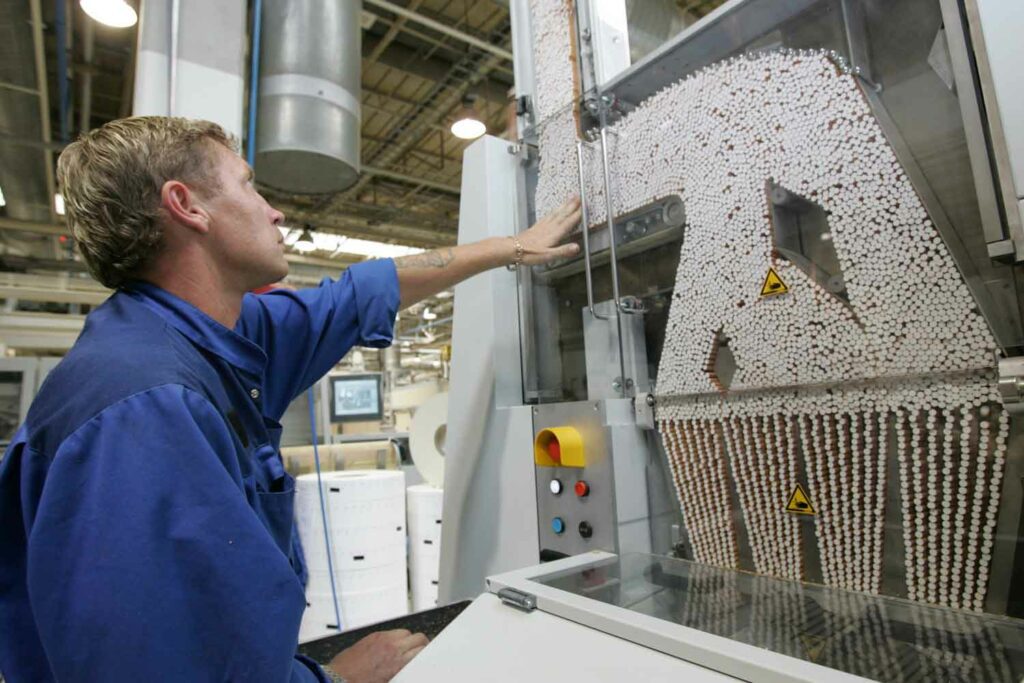
Vice Ventures has carved out a niche investing in good companies in “bad” industries.
By Stefanie Rossel
For startups in the reduced-risk nicotine product business, raising money can be an almost insurmountable hurdle. In addition to the typical challenges faced by new enterprises, they must cope with unfavorable perceptions: Due to the tobacco industry’s controversial legacy, any company associated with the sector—however remotely—continues to carry a stigma in the eyes of many. For some venture capital funds, this makes investment in such companies a no-go. Many of them even have specific clauses prohibiting investments in “bad” businesses.
Venture capitalist Catharine Dockery repeatedly ran into this issue when pitching her investments in the late 2010s. With the possibility of recession looming on the horizon, she was convinced that the best way to earn a return on capital was to invest in “vice” brands, with companies such as Altria Group and Diageo historically outperforming others in times of economic hardship. Yet many of the investment firms she applied to had provisions blocking such investments.
Getting nowhere with established firms, Dockery in 2018 established Vice Ventures, a financial firm without inhibitions about investing in so-called sin industries. Remarkably, many of the fund managers who had rejected her strategies due to their employers’ restrictions ended up investing in Vice Ventures with their personal money, endorsing the validity of her approach.
The venture capital firm started with a $25 million fund, raising money from family offices and high-profile investors like Marc Andreessen and Bradley Tusk. It was followed by a second fund of the same size last year. In 2020, Forbes recognized Dockery in its “30 Under 30” ranking, an index that recognizes notable young entrepreneurs in various industries.
While Vice Ventures invests in companies catering to vices, such as alcohol, cannabis and nicotine, it takes a sober, analytical approach. By selecting good companies—those that have the power to grow explosively without hurting people—in a bad environment, Dockery says she is looking for “the virtue in the vice.”
“We’re focused on finding responsible operators in categories where other funds often won’t get involved,” she explains. “We see nuance in this space in the sense relative to the typical fund view of entirely black or white by category.”
Dockery is convinced that vice startups, and by extension vice investors, can generate returns while still being mindful of the social good. The reputational problems of the sector stem from the tobacco industry’s past behavior. The big tobacco firms, for example, spent years downplaying the risks of smoking. Even though many of them have changed their conduct, that legacy still taints the sector today. Dockery detects a double standard, though, noting that investors who object to tobacco may have no qualms about funding companies that have contributed to and covered up the impact of climate change, for example.

“Our most important criterion for evaluation is legality and feasibility of the business plan.”
Catharine Dockery, Vice Ventures
Ethical Investments
Dockery spent much time determining how morals would influence her strategy and then developed some rules to guide her decisions. Good investments, she argues, have founders and leaders who are ethical and honest. Good vice products, meanwhile, are created for, marketed to and consumed by consenting, responsible and understanding adults who have power over their decisions. According to Dockery, good vice companies care about their customers and have real-world expectations for their behavior while good vice products inform users how consumption may affect them.
Evaluated against these criteria, investing in reduced-harm nicotine products, with cigarettes killing over 480,000 Americans each year, according to health groups, is a logical and ethical step. “There is significant research suggesting that having flavored recreational options available to adult smokers is a useful public health tool,” says Dockery. “Vice Ventures is quite active in investing in early-stage nicotine companies, including both recreational products that require premarket tobacco product application (PMTA) approval and nicotine-replacement therapy (NRT).”
The first startup Vice Ventures financed in the nicotine sector was Lucy Goods, a Nevada-based manufacturer of recreational and NRT oral nicotine products. Lucy Gums, the company’s nonmedical flagship product, is advertised as an upgraded version of the classic nicotine gum, coming with “stronger flavors, better texture and packaging you don’t have to be a rocket scientist to open.”
A behavioral study, published in Harm Reduction Journal in January, concluded that Lucy Gums helped prevent nicotine cravings among participants, did not appear to attract those who never used tobacco products and had low potential to promote nicotine relapse among former tobacco users. Results suggested minimal appeal to youth, and there was no evidence that Lucy Gum flavors appealed more to young adults than to older adults. “The fact that Lucy appeals to people who smoke, regardless of their intent to quit smoking, highlights the potential of Lucy to reach more adult tobacco users than medicinal NRT products and to facilitate their transition to less harmful alternatives,” said Lucy Goods’ co-founder and CEO, David Renteln. With a 0.3 percent reduction in population-level smoking rate projected for a 2.3 percent quitting rate, current smoking cessation methods show limited effectiveness.
“While not a cessation product, Lucy is positioned in a crucial middle ground, targeting nicotine users who want to address the harms of consumption, consume nicotine in new and enjoyable ways, and potentially, in the future, work toward reducing consumption,” Dockery says. In May 2022, Lucy Goods submitted PMTAs for 42 nicotine products.
Vice Ventures also led the financing of Qnovia’s Series A funding in 2022. The Richmond, Virginia-based startup raised $17 million, which it said it would use to move forward an investigational new drug submission to the U.S. Food and Drug Administration and begin human clinical trials for its NRT drug candidate.
Qnovia has developed RespiRx, a handheld, pocket-size atomizer capable of producing vapor without heat, which the company hopes will become the first FDA-approved, prescription-only inhalable NRT solution (see “High-Tech Quitting,” Tobacco Reporter, March 2023). In late 2023, trial results showed that the drug delivery platform had an “exceptional” pharmacokinetic profile compared to existing NRTs.
Qnovia claims it has the potential to fill the void for more effective pharmacotherapies and NRTs, as traditional treatments fail to deliver nicotine rapidly, which is crucial when trying to alleviate withdrawal symptoms.
Chicago-based Black Buffalo, another company partially funded by Vice Ventures, has created a moist smokeless tobacco alternative based on nicotine-infused edible leaves from the cabbage family. According to Black Buffalo, the leaves’ properties are similar to those of tobacco in terms of texture, aroma, color and flavor. While smokeless tobacco products, such as dip, snuff and chewing tobacco, remain popular in the U.S., with sales reaching $4.98 billion in 2022, according to the Federal Trade Commission, societal attitudes toward oral nicotine use have been shifting. Black Buffalo’s products are aimed at moist smokeless tobacco consumers migrating away from traditional tobacco products.
Focus on Harm Reduction
So what does it take for a nicotine startup to successfully pitch with Vice Ventures? “Our first, most important criterion for evaluation is legality and feasibility of the business plan,” says Dockery. “Nicotine companies often face exceptionally long regulatory timelines and complex regulations, so we need to feel confident that the management team can navigate that landscape.”
While Vice Ventures tends to evaluate companies on an individual basis rather than a category basis, it is especially focused on the concept of harm. “There is a myriad of ways a product can cause harm to the consumer or society, regardless of the company involved,” says Dockery.
There are also characteristics that exclude contenders. “We frequently receive pitches for products, especially in nicotine, that are planning to operate in ways that don’t meet our investment criteria,” says Dockery. For example, Vice Ventures is uninterested in the delta-8-tetrahydrocannabinol (THC) products that have rapidly gained popularity following the passage of the 2018 U.S. Farm Bill, which legalized industrial hemp with THC levels below 0.3 percent dry weight. The fact that delta-8 products exploit a regulatory loophole has prompted Vice Ventures to stay away from the sector.
Due to the regulatory landscape, nicotine is a bit of specialty sector in Vice Ventures’ broad portfolio. According to Dockery, convincing investors depends to a large extent on the person. “We have a track record of approaching this field in a very responsible way, which helps a lot,” she says. “Professional investors often engage with our fund the most readily because they understand the opportunity we’re working to capitalize on. Many of our fund investors are passionate co-investors, so they are frequently involved alongside the fund in our investments.
“Outside of Vice Ventures, co-investors largely depend on the sector we’re investing in. For some of our more regulatory-intensive categories like nicotine, we often see private and high-net-worth investors instead of funds involved in early stages of companies.”
Over the next five years, Dockery plans to continue growing the fund’s scale and reach. With the $25 million fund closed last year, the company is looking to develop approximately 30 best-in-class early-stage domestic and international companies in various vice industries. “We’re already a well-known partner for early-stage capital in our verticals, and there is natural room to grow over time,” she says. “Venture capital represents one of the most niche areas of the investment market, and our position as an early-stage partner will set us up for unique long-term relationships with top startups.”







































